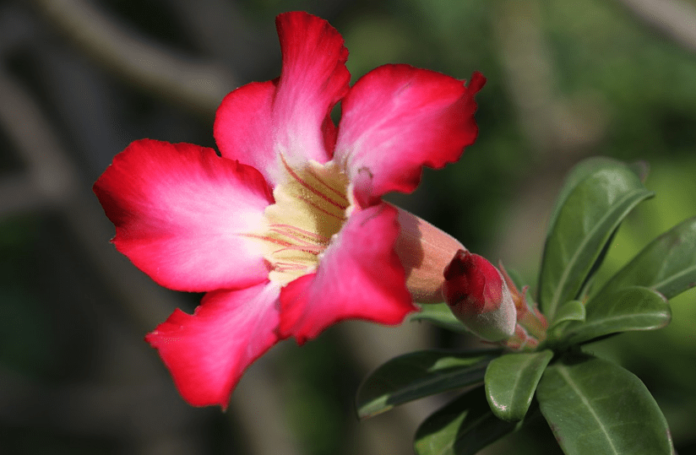Scientifically named as Adenium obesum, the Desert Rose Bonsai is a magnificent plant that blends the rough beauty of the desert with the delicate aesthetics of a traditional bonsai. The Desert Rose, which is native to parts of Africa and the Arabian Peninsula, has captured the attention of gardeners and bonsai lovers worldwide with its vivid blossoms, elongated trunk, and exceptional adaptability. This article will discuss the traits, maintenance needs, growing methods, and symbolic meanings of the Desert Rose Bonsai.
Table of Contents
Characteristics of the Desert Rose Bonsai
Because of its eye-catching characteristics, the Desert Rose Bonsai is a remarkable plant that shines out. The following are a few of the more noteworthy qualities:
- Swollen Trunk: The caudex, or swollen, water-storing trunk, is one of the most distinctive characteristics of the Desert Rose Bonsai, giving the plant a distinctive, almost sculptural appearance. Because of this trait, the plant can hold onto moisture and endure dry conditions, which makes it an ideal specimen for bonsai cultivation.
- Bright Blooms: Pink, red, white, and occasionally even bi-colored flowers are produced by the Desert Rose Bonsai. These blooms, which give a pop of color to your bonsai collection, can remain for several weeks and appear in clusters at the terminals of the branches.
- Leathery, Glossy Leaves: The Desert Rose’s leathery, glossy leaves adjust to the plant’s requirement to retain moisture in arid environments. They usually have an oval shape and are found at the tips of the branches.
- Growth Habit: The Desert Rose Bonsai grows relatively quickly in contrast to many other bonsai species. Given the right care, it can even acquire a thickened trunk and branch structure that will make it appear elegant and antique at a young age.
Caring for a Desert Rose Bonsai
While it is a very low-maintenance plant, the Desert Rose Bonsai needs special attention to survive. Here is a thorough instruction manual for maintaining this unusual bonsai:
- Light Requirements: The Desert Rose Bonsai needs at least 6 to 8 hours of direct sunshine every day because it loves the sun. To ensure that it receives adequate light, place it in a sunny area, such as a windowsill or outside in a garden. If you’re cultivating it indoors, especially in the winter, think about adding a grow lamp to supplement natural light.
- Watering: The Desert Rose doesn’t need to be watered frequently because it is a succulent and is accustomed to dry environments. When the soil is completely dry to the touch, give it a good irrigation, being careful not to overwater as this might cause root rot. Water it more often in the spring and summer while it is growing, but lessen the amount in the fall and winter when it becomes dormant.
- Temperature and Humidity: The ideal temperature range for the Desert Rose Bonsai is between 65°F and 90°F (18°C and 32°C). Because it cannot withstand frost, it should be kept indoors in cold weather or when the temperature falls below 50°F (10°C). Because it requires low humidity, indoor situations are appropriate for this plant.
- Soil: For the Desert Rose Bonsai, a well-draining soil mixture is necessary. Use a potting mix made specifically for cacti or succulents, or mix your own using equal parts sand, perlite, and bonsai soil. This guarantees rapid drainage of surplus water, so averting root rot.
- Fertilizing: During the growing season (spring and summer), give your Desert Rose Bonsai a balanced fertilizer that is soluble in water every four to six weeks. Since the plant is dormant in the fall and winter, do not fertilize during these times. Increasing the amount of phosphorus in the fertilizer can help promote more blooms.
- Shaping and Pruning: A vital part of bonsai maintenance is pruning, and the Desert Rose Bonsai is no exception. Frequent trimming promotes additional branches and helps the plant keep its structure. Eliminate any yellowing or dead leaves, and trim back any lanky growth or branches that interfere with the intended shape. The bonsai can also be shaped by gently wiring the branches; however, exercise caution, as the branches may break easily.
Propagation and Repotting
- Propagation: Cuttings or seeds can be used to grow more Desert Rose Bonsai plants. Even though seeds could take longer to sprout, you can start cultivating a distinctive caudex shape at a young age. Cuttings usually result in flowers sooner and happen faster. Cuttings should be taken with a sharp, sterilized knife, and they should be let to dry for a few days before being planted in a soil mixture that drains properly.
- Repotting: In order to replenish the soil and allow for root development, repotting is necessary every two to three years. When the plant enters its active development phase in the spring, it’s ideal to repot it. Select a little larger pot and fill it with recently blended, well-draining soil.
Symbolism and Cultural Significance
The Desert Rose Bonsai is an intriguing addition to any bonsai collection since it has multiple metaphorical meanings:
- Adaptability and Resilience: The plant’s capacity to flourish in arid, harsh conditions is a symbol of adaptability and resilience. It acts as a reminder of the fortitude and tenacity required to face life’s obstacles.
- Beauty in Adversity: The idea that beauty can thrive even in the most adverse circumstances is symbolized by the contrast between the fragile blossoms and the rough trunk. Because of this, the Desert Rose Bonsai is a heartfelt present for someone who has triumphed over hardship.
- Fertility and wealth: The desert rose is seen as a symbol of fertility, abundance, and wealth in various civilizations. Its colorful blooms and enlarged caudex are regarded as symbols of health and growth.
Pests and Common Issues
Despite its relative hardiness, the Desert Rose Bonsai is not immune to pests including mealybugs, aphids, and spider mites. Examine your plant on a regular basis, and use neem oil or insecticidal soap to cure pests. Make sure your bonsai is placed in soil that drains properly and refrain from overwatering it as this is the most prevalent cause of root rot.
Conclusion
The striking Desert Rose Bonsai combines the hardiness of desert vegetation with the elegance of bonsai art. Its eye-catching blossoms, substantial trunk, and versatility make it an excellent option for novices and seasoned bonsai enthusiasts alike. You can grow an amazing Desert Rose Bonsai that will flourish and look gorgeous as a focal point in your house or yard by following the care instructions. The Desert Rose Bonsai is an unforgettable and satisfying experience, demonstrating that even the most hardy plants can create the most magnificent beauty, whether you are drawn to it by its vivid blossoms, sculptural form, or symbolic significance.





